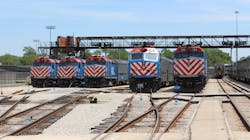Commuter rail industry’s liability insurance challenges approach crisis level
The Commuter Rail Coalition (CRC) and the American Public Transportation Association (APTA) is putting the spotlight on liability insurance required by commuter rail providers in the U.S. and the increasing challenges these service providers are facing to affordably acquire the needed coverage.
Commuter rail entities, under contracts with host railroads who own the infrastructure the service operates over, are required to carry liability coverage that is currently capped at $323 million under the Fixing America’s Surface Transportation Act (FAST Act).
The first federal liability cap went into effect in December 1997 and commuter rail operators reported coverage to be affordable and available for much of the time after 1997. However, CRC and APTA say recent reductions in available capacity coupled with increasing costs – referred to as hardening of the market – threatens the sustainability of commuter rail operations. Should a commuter rail operator be unable to acquire the needed level of insurance per a contractual obligation, operations could be interrupted or suspended.
A new report from APTA, “APTA Recommendation on Commuter Rail Liability Insurance,” has determined current conditions will not improve in the short term, “The current ‘hard market’ is expected to continue for several years. There are indications that a new baseline has been established, and that there is not likely to be a future correction through a ‘softening’ of the market by additional insurers entering the market and providing additional needed capacity.”
While both CRC and APTA recognize the hardening of the market impacts other industries that carry high-level liability insurance coverage, its impact to commuter rail providers do not match the current level of risk.
In a July 12 letter to the Senate Banking Committee, Metra CEO Jim Derwinski, President of the South Shore Line Mike Noland, Acting Executive Director of Caltrain Michelle Bouchard, Connecticut Department of Transportation Commissioner Joseph Giulietti, New Jersey Transit President and CEO Kevin Corbett, Southeastern Pennsylvania Transportation Authority General Manager and CEO Leslie Richards, South Florida Regional Transportation Authority Executive Director Steven Abrams and Virginia Railway Express CEO Rich Dalton wrote:
“There are myriad reasons for this hardening of the market, but none call into question the safety of commuter railroads. The excess insurance markets have vastly decreased the amount of coverage they wish to dedicate to insuring commuter rail. In 2020 alone, excess liability insurance coverage for commuter railroads decreased by nearly $450 million. Of the 24 key insurers who have historically offered excess liability insurance coverage in the foreign marketplaces (London, Bermuda, Dublin), 15 insurers have reduced their commuter rail capacity by an average of 50 percent and nine have withdrawn from the marketplace altogether. Very few domestic insurance carriers offer coverage to commuter railroads; none offer coverage above the $50 million attachment point.”
The new report from APTA references the relatively low loss history of the commuter rail industry, as well as certain agencies that have few to no losses.
“Risk of serious accidents has further decreased with the significant investment made by Commuter Rail Agencies in Positive Train Control (PTC). Due to the COVID-19 pandemic, commuter rail ridership has decreased dramatically for more than a year, diminishing total potential liability to passengers and fare revenues. Neither the availability nor cost of excess liability coverage is commensurate with the current risk,” the APTA report states.
Both APTA and CRC support the federal government stepping in and are recommending the establishment of a Commuter Rail Insurance Program at the U.S. Department of Transportation (USDOT) to provide insurance to commuter rail agencies operating in the U.S.
“Commuter rail is a key component of improved public transit infrastructure, enhanced mobility, economic recovery and addressing climate change. Without federal intervention, commuter rail agencies will continue to face a significantly reduced market capacity for coverage along with unreasonable premium costs, threatening operations,” said APTA President and CEO Paul P. Skoutelas. “The stability that federal involvement could bring would help foster the desired investment in infrastructure, as well as addressing the economic and operating challenges that these agencies face.”
The legislative language for the Commuter Rail Insurance Program has been developed by the commuter rail industry and modeled after provisions within the Federal Aviation Administration’s Air Transportation Safety and Systems Stabilization Act, the Terrorism Risk Insurance Act and other laws concerning federal insurance program brought about by insurance sector market failures.
The letter from commuter rail stakeholders to the Senate Banking Committee says the commuter rail insurance program would continue only for as long as capacity limits exist to insure commuter rail operations.
“This program would offer insurance to commuter rail agencies that offer commuter rail services (either directly or operated through contracted services) to cover passenger injuries or damage to the property arising out of or in connection with the operation of commuter rail service. The proposed program is voluntary and all participating commuter rail agencies would pay a premium established by the [USDOT],” the letter reads.
About the Author

Mischa Wanek-Libman
Group Editorial Director
Mischa Wanek-Libman is director of communications with Transdev North America. She has more than 20 years of experience working in the transportation industry covering construction projects, engineering challenges, transit and rail operations and best practices.
Wanek-Libman has held top editorial positions at freight rail and public transportation business-to-business publications including as editor-in-chief and editorial director of Mass Transit from 2018-2024. She has been recognized for editorial excellence through her individual work, as well as for collaborative content.
She is an active member of the American Public Transportation Association's Marketing and Communications Committee and served 14 years as a Board Observer on the National Railroad Construction and Maintenance Association (NRC) Board of Directors.
She is a graduate of Drake University in Des Moines, Iowa, where she earned a Bachelor of Arts degree in Journalism and Mass Communication.
